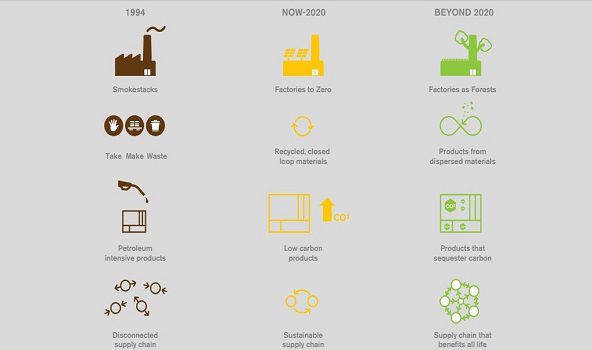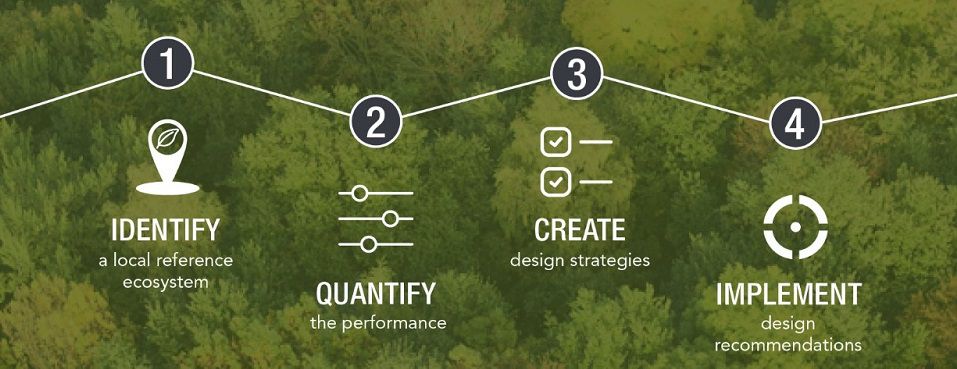Interface has a history of looking to nature for inspiration. When the company first embraced sustainability in 1994, one of the first questions we asked was “If nature designed a company, how would it function?” This early thinking helped us create a framework to redesign our business to become one that had no negative impacts and a restorative influence.
In collaboration with Biomimicry 3.8, we developed a methodology for which we and other companies can transform facilities from ‘zero footprint’ to provide the same benefits as high-performing ecosystems. We call this methodology, “Factory as a Forest” (FaaF).
Erin Meezan, Chief Sustainability Officer at Interface, and Nicole Hagerman Miller, Managing Director of Biomimicry 3.8, recently spoke about the methodology at Sustainable Brands Vancouver, and will speak again at Sustainable Brands Buenos Aires in September 2018. Here, the duo engages in conversation about the methodology and its ability to be used universally.
“Factory as a Forest” created quite a buzz at SB’18 Vancouver. How did this collaboration between Interface and B3.8 come about?
Erin Meezan: In 2016, Interface made the bold decision to move beyond Mission Zero® to envisioning ourselves as a positive business. It was Janine Benyus from Biomimicry 3.8 who connected our vision with a thought-provoking question Ray Anderson asked her at the very beginning of Interface’s sustainability journey – “How do we make our company function like a forest?” It also resonated with Janine and her team’s work around Ecological Performance Standards (EPS) which led to this pioneering collaboration. The idea was to build metrics that would serve as benchmarks for our business to change the way we build and operate our factories.

Interface Roadmap: Smokestacks to Mission Zero to Factories as Forests.
Nicole Miller: What we’re driving for is a holistic strategy for companies that can support and align with other sustainability goals and building standards. The collaboration between B3.8 and Interface has started an entire conversation around using nature as our ultimate benchmark and that once we perform at that level then we reach true sustainability. The concept provides a vision for initiatives that may otherwise seem fragmented, but ultimately support a longer-term goal of moving beyond net zero.
What inspired the FaaF methodology?
EM: FaaF is based on two core beliefs. The first is that nature is an amazing model for sustainability and productivity, and the second was around the emerging thinking of positive impact. It was developed through a multi-year, iterative method into a four-step process. The initial studies around a local ecosystem and its functions were conducted at our factory in Minto, Australia. The methodology was then taken to the factory in LaGrange, Georgia, where the actual metrics were developed. We are now in the first phase of implementing some of the design recommendations.

Four steps from the factory floor to the forest floor.
Is the methodology only applicable to manufacturing facilities or is there potential for scaling?
NM: The intention of the project is to move beyond the factory walls at LaGrange and to engage with other manufacturers in and around the area to have a larger impact. We’re exploring how we could leverage our knowledge from LaGrange to determine what could work for other projects. As we start to do this, all the metric-oriented design ideas that we develop become a repository of best practices that we can build on as we learn more about different ecosystems.
EM: FaaF is about applying biomimicry on a larger, systemic scale than just applying it to product design. We’ve also used the methodology developed for LaGrange to influence the design of the new Interface Americas headquarters building in downtown Atlanta, since both belong to the same ecosystem. Usually the metrics developed for one project cannot be replicated in other facilities, as every high-performing ecosystem is incredibly complex.
Interface’s manufacturing facility at LaGrange employs more than 1000 people. What was the employee buy-in for this project?
NM: We knew the goals were ambitious, so we weren’t sure how they would be received. What we found was that employees not only were super engaged with learning about their local ecosystems, but also the fact that we were using this information to create a better work environment proved to be a large driver for employee support.
Can the metrics developed at one site be replicated in another?
EM: Once we identified the key functions and EPS of our local ecosystem, we had to screen that against the size of the company and our sustainability goals and aspirations, apart from other factors such as the amount of land available, the site realities and the constraints we might have while the factory performs like its natural ecosystem.
NM: While we know that carbon, water, soil, atmosphere and biodiversity are crucial metrics, we also know that each site is unique and to look at other features that could be specific to that ecosystem. The data collection and gap analysis help us identify the right benchmarks for our buildings based on location.
While Interface has always had a strong focus on sustainability, did it take some convincing to get the senior team on board?
EM: None of the senior team needed any convincing to get on board, and I think that’s just a reflection of Interface’s goals. For future projects, we would like to engage with the operations and facilities teams early on to increase familiarity and obtain feedback.
If you faced any challenges while implementing FaaF, how did you overcome them?
EM: The challenges we encountered were unique to pioneering a project. The first was having to seek budget allocation for the project without knowing the result or final cost. The second was that going into the future, the functioning of our factories would be based on an aspirational plan rather than a concrete one. Our long-term vision of having a positive impact and B3.8 envisioning that future for us helped to overcome these challenges.
What is the future of the Factory as a Forest project and how can others be a part of the FaaF journey?
NM: The next step for us is to share our experiences with others. It’s very important that we help people see this goes beyond a vision, that it is real, tangible with measurable impacts – both short- and long-term. As an immediate step, we’ve created an assessment tool to see if this is something that’s right for you/your organization. And for those who want to be part of the journey, in either replicating Interface’s metrics at LaGrange or quantifying your own site’s performance goal, please feel free to reach out to me at nicole.miller@biomimicry.net.
Featured Image Photo Credit: Talia Arbit
2 responses to “Factory as a Forest: Reimagining Facilities as Ecosystems”
Oh yes please. This is an amazing project and would like to know what the steps taken and outcome will be.
Thank you Erin & Janine.
I truly believe the answers we seek with regards correcting the wrongs of the Industrial revolution are to ve found in nature.
The thought of a factory as a forest came to me and I thought I would see if there was anything out there on this idea. To my delight and surprise I found you.
I would be very much interested to learn more about your project and how it is progressing. If I vould add value in anyway I would be interested to have that conversation too.